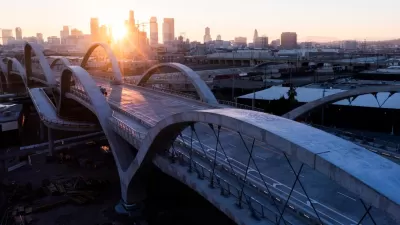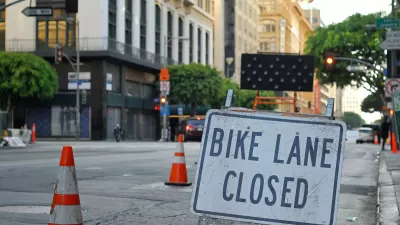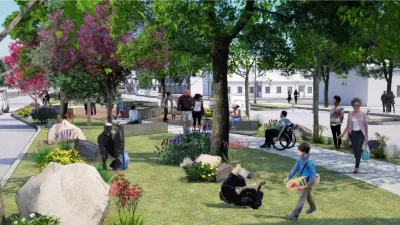Bike and pedestrian infrastructure on the much-anticipated new bridge leaves much to be desired, according to advocates.

“The brand-new 6th Street Bridge over the L.A. River, connecting Boyle Heights to the Arts District, was supposed to be a symbol of the city’s move away from a car-centric past and toward a future of more pedestrians and cyclists. It had been open for about a week before drivers plowed into not just one bike lane but both of them simultaneously,” writes Alissa Walker in Curbed.
Despite years of warnings from pedestrian and bike advocates and an ambitious early design, which included a separate level for pedestrians and cyclists, Walker argues that the bridge was not built to prevent such crashes or protect pedestrians and people on bikes. “There are four lanes of fast-moving traffic separated from its two bike lanes by plastic tubes mounted on rubber slabs screwed into the roadway more than a vehicle-width apart.” Additionally, “At either end, where the $588 million bridge touches back down to the grid, the walkways peter out into a narrow sidewalk with a single diagonal curb ramp and the barely protected bike lanes evaporate into sharrows, forcing cyclists to share vehicular lanes without any plastic between them at all.” After Monday’s crash, a bumper from one of the three cars involved still lay in the bike lane, forcing commuters to swerve around it.
Walker describes some “relatively easy fixes” the city could make to improve the as-yet-unfinished bridge: a median to prevent racing, dedicated bus lanes, K-rail barriers protecting the bike lanes. However, Walker opines that “the city almost certainly won’t make them,” focusing instead on civic events and film shoots—the latter of which will likely close the bridge to everyone during filming.
FULL STORY: A Bike Lane Built for a Car Crash

Alabama: Trump Terminates Settlements for Black Communities Harmed By Raw Sewage
Trump deemed the landmark civil rights agreement “illegal DEI and environmental justice policy.”

Planetizen Federal Action Tracker
A weekly monitor of how Trump’s orders and actions are impacting planners and planning in America.

The 120 Year Old Tiny Home Villages That Sheltered San Francisco’s Earthquake Refugees
More than a century ago, San Francisco mobilized to house thousands of residents displaced by the 1906 earthquake. Could their strategy offer a model for the present?

In Both Crashes and Crime, Public Transportation is Far Safer than Driving
Contrary to popular assumptions, public transportation has far lower crash and crime rates than automobile travel. For safer communities, improve and encourage transit travel.

Report: Zoning Reforms Should Complement Nashville’s Ambitious Transit Plan
Without reform, restrictive zoning codes will limit the impact of the city’s planned transit expansion and could exclude some of the residents who depend on transit the most.

Judge Orders Release of Frozen IRA, IIJA Funding
The decision is a victory for environmental groups who charged that freezing funds for critical infrastructure and disaster response programs caused “real and irreparable harm” to communities.
Urban Design for Planners 1: Software Tools
This six-course series explores essential urban design concepts using open source software and equips planners with the tools they need to participate fully in the urban design process.
Planning for Universal Design
Learn the tools for implementing Universal Design in planning regulations.
Clanton & Associates, Inc.
Jessamine County Fiscal Court
Institute for Housing and Urban Development Studies (IHS)
City of Grandview
Harvard GSD Executive Education
Toledo-Lucas County Plan Commissions
Salt Lake City
NYU Wagner Graduate School of Public Service





























